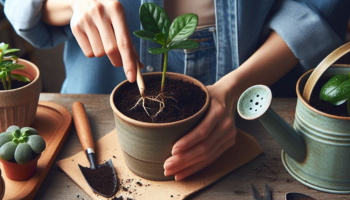
Bringing home a vibrant new plant is exciting! But then the question arises: should you repot it right away? This seemingly simple decision can trigger anxiety in even the most seasoned plant parent.
The Case for Waiting:
- Acclimatization: Imagine moving to a new country – it takes time to adjust! Similarly, your plant needs to acclimate to your home’s light, humidity, and temperature. Repotting adds another stressor, potentially leading to leaf drop or stunted growth.
- Root Disruption: Nursery pots are often small, but that doesn’t necessarily mean they’re bad. The roots have likely adapted to the confined space, and repotting can damage them, hindering water and nutrient uptake.
- Post-Purchase Blues: Plants often experience “transplant shock” after purchase due to changes in environment and handling. Repotting on top of that can double the shock, delaying recovery.
Signs Your Plant Needs a New Pot:
So you’ve recently brought home a new plant and you’re wondering if it needs a new pot? Well, there are some signs to look out for. Firstly, check the roots of your plant. If they have started to grow through the drainage holes at the bottom or are tightly circling around the inside of the pot, it’s time for an upgrade. Another indication is when your plant is showing signs of stunted growth or wilting despite regular watering. This could mean that the current pot is too small, restricting root development and causing waterlogged soil. Additionally, if you notice that water is not properly draining from the pot after watering or there is a strong odor coming from it, it’s a clear sign that your plant needs a new home. Remember, choosing a pot with proper drainage and sufficient size will allow room for healthy root growth and support your plant’s overall well-being!
- Roots Overflowing:
If roots are peeking out of drainage holes or circling the top of the soil, it’s time for a bigger pot. - Stunted Growth:
Despite proper care, if your plant isn’t growing for months, it might be rootbound, restricting its ability to expand. - Frequent Watering:
Does the soil dry out super quickly, requiring constant watering? This could indicate insufficient soil volume for the root system. - Top-Heavy Wobble:
If your plant seems unstable and prone to tipping over, it might need a larger pot for better balance and root support.
Making the Decision:
Ultimately, the repotting decision depends on your specific plant and situation. Here’s a quick guide:
- Wait 2-4 weeks: Generally, it’s best to let your plant settle in for a few weeks before repotting. This gives it time to adjust and reduces transplant shock.
- Exceptions exist: If the plant shows signs of rootboundness, overwatering, or unsuitable soil (like peat moss for moisture-loving plants), immediate repotting might be necessary.
- Choose the right pot: Opt for a pot only 1-2 inches larger than the current one. Avoid oversized pots, as they can lead to waterlogging.
- Gentle repotting: Carefully loosen the roots, remove old soil (if needed), and place the plant in fresh, well-draining potting mix.
Remember: Repotting is a stressful event for any plant. Be patient, provide proper care, and your new leafy friend will soon thrive in its new home. Happy planting!
Bonus Tips:
- Research your specific plant’s needs for repotting frequency and pot size.
- Use high-quality, well-draining potting mix suitable for your plant type.
- Water the plant thoroughly after repotting to settle the soil and encourage root growth.
- Avoid fertilizing for a few weeks after repotting to allow the plant to recover.
With a little knowledge and care, you can ensure a smooth transition for your new plant, setting it up for success in its leafy journey. And remember, even if you make a mistake, plants are resilient! Just learn from the experience and keep nurturing your green companions.

